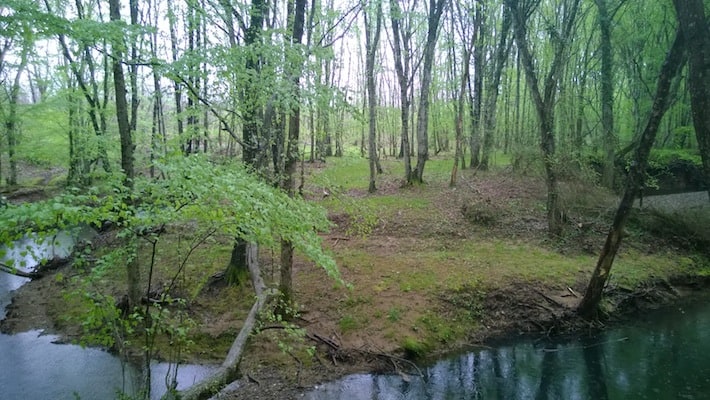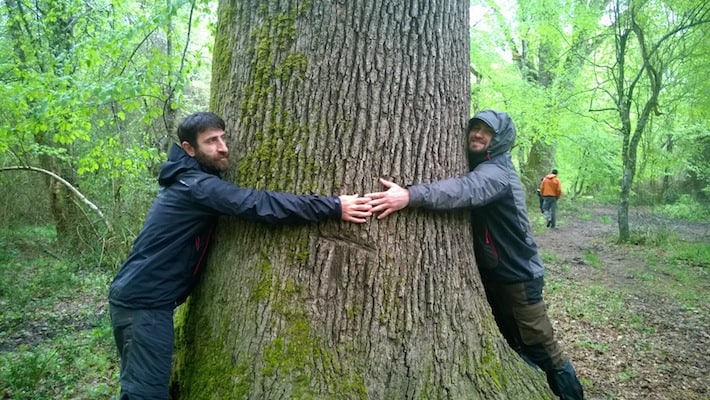
About twenty minutes into our walk, our guide hushed us. We were about to enter the Iğneada Longoz Forests National Park, and he asked that we be absolutely quiet for the next hour—not an easy feat for a group of about fifteen Turks (plus me, the one lone foreigner).
“Just listen,” he said.
In the cathedral of the forest there was music all around us: Tiny frogs chortled, so camouflaged they were barely visible. Birds chirped from the high trees in a call-and-response as water dripped a soft tattoo. Even the air seemed to thrum with life as we walked through the forest, surrounded by vibrant green trees reflected in numerous pools. All human noise ceased apart from our shoes making soft squelching noises on the wet, wooded paths. I took deep gulps of the wet, sweet-tasting air, imbibing the life and calm of the place.
Our guide Mikail, who himself looked as if he might have been carved from a tree, was from a tour company called Bukla, which in the Laz language means “tree root.” And fittingly, most of the guides do hail from the Black Sea region, the native land of the Laz peoples. They work in and around Istanbul throughout the winter, and then head home for the summer to do tours there.
Though I am not generally a fan of guided tours, Bukla is very well-run, and the people involved seem to genuinely care about Turkey’s natural sites and have a passion for the preservation of these sites. The guides are knowledgeable, well-educated, funny, and thoughtful. Mikail even had a spare pair of hiking boots for me. Both the Ked-like sneakers and running shoes I had brought along would surely have been destroyed on this hike, probably sucked up by the mud forever. Though the boots were one size too big, I doubled up on the socks and so was sans foot worries, free to marvel at the strange beauty of the place.

Iğneada is truly a strange and beautiful place. It is something of a marsh, something of a rainforest, although technically it is neither. The National Parks of Turkey website describes it as a “flooding forest,” which makes sense seeing as the land here is completely covered with water in winter and spring. The term longoz refers to this special kind of wetlands. Ensconced within the forests are seven lakes and countless types of flora, trees, fish, and animal life.
With such ecological and biological diversity, it is unfathomable to me that the government would plan to build a nuclear power plant here. Although this plan is halted at the moment because of the uproar made by locals and activists, the government has still not given up on the idea. For now, the local community is putting their hopes in an application to UNESCO to have the forest become a protected World Heritage site.
The entire trip to Iğneada lasted two days. We began our journey early Saturday morning at the Kadıköy Evlendirme Dairesi (Marriage Office) and stopped in Mecidiyeköy and Bakırköy to pick up others on the European side before heading into Kırklareli, an area along the Black Sea at the western end of the Marmara region that begins to nuzzle up to Bulgaria. Just before Lüleburgaz, we stopped to fuel up on tea and poğaça and then rolled through farmland and mountain roads northward and inland before swerving back east again, down from the hills to the sea. Altogether it was about a four-hour drive including stop time.
The first day there was gorgeous and sunny, so I chose to stay on the beach and near the pool while others took a shorter planned walk that hugged the coast. The trip was actually striking in this contrast: Day one lounging on the beach, with some even jumping into the still-frigid Black Sea. The next in the emerald and chartreuse green, the mulch and mud and rain of the forests.

The food was great all weekend too. We had köfte for lunch in Iğneada town, a food Thrace is known for. We were served a delicious buffet for dinner at the Iğneada Resort Hotel and one of those mile-long Turkish breakfasts the next morning. On the way back to Istanbul, we also stopped in a village for some creamy-tart manda yogurt made from water buffalo milk.
Toward the end of our hike in the national park, Mikail stopped to hug a tree. It seems cliché but actually seeing someone hug a tree is very catchy, and it feels great to do. There is so much life in the great barky girth of a tree trunk. Soon we were all hugging trees, snapping photos, reaching our fingers around to touch.
Speaking of fingers, let’s cross them and hope that this unique and marvelous spot will indeed soon become a protected UNESCO Natural World Heritage site.
For more information on the forest, check out the National Parks of Turkey website. For accommodation, I recommend the Iğneada Resort Hotel; more information on the resort can be found here.
Zamira Skalkottas is a contributor to Yabangee.









